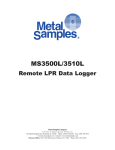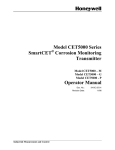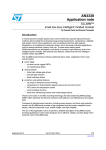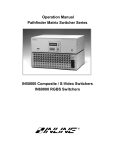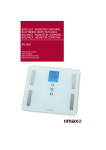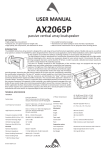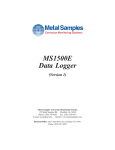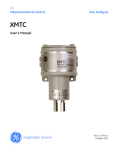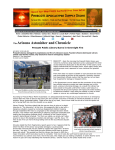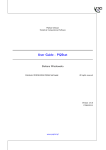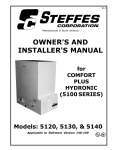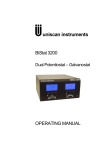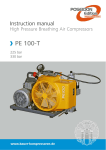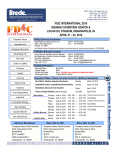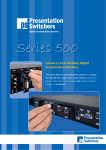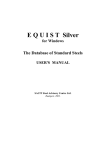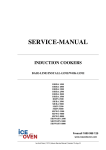Download MS1500L manual (revised 4-7
Transcript
MS1500L LPR Data Logger Metal Samples Company A Division of Alabama Specialty Products, Inc. 152 Metal Samples Rd., Munford, AL 36268 Phone: (256) 358-4202 Fax: (256) 358-4515 E-mail: [email protected] Internet: www.metalsamples.com Table of Contents I. Introduc on ..................................................................... 1 A. Instrument Func on Overview .................................. 1 B. Instrument Parts List .................................................. 4 C. Specifica ons ............................................................. 5 D. Ba ery Installa on ..................................................... 6 E. Computer Download Hook-Up ................................... 7 F. Adapter Use ............................................................... 8 II. Instrument Opera on .................................................... 10 A. Start-Up and Opera ons Overview .......................... 10 B. Select Probe I.D. ....................................................... 14 1. General ................................................................ 14 2. Enter New Probe .................................................. 15 3. Delete Probe ........................................................ 19 C. Make Measurement ................................................. 22 D. Recall readings ......................................................... 25 E. Delete readings ........................................................ 27 F. UNS Constant Table .................................................. 29 1. General ................................................................ 29 2. Addi on/Dele on of UNS Codes ......................... 30 G. Communica ons ...................................................... 32 III. Theory of Opera on ...................................................... 42 IV. Tes ng the MS1500L with the LPR Meter Prover .......... 52 V. Appendices .................................................................... 54 Appendix 1 - Deriva on of Alloy Constant..................... 54 Appendix 2 - Returning Instrument ............................... 62 Appendix 3 - Warranty................................................... 64 I. IntroducƟon A. Instrument FuncƟon Overview The MS1500L is a hand-held measurement and data collec on device. It is lightweight, easily handled, and ba ery operated so that it can be carried to any loca on where measurement or data collec on is required. The MS1500L has several measurement func ons: • • • • • 3-Electrode Linear Polariza on (corrosion-rate) 2-Electrode Linear Polariza on (corrosion-rate) “Pi ng Index” Zero Resistance Ammetry Electrode Poten al This versa lity allows the unit to be used with all commercially available corrosion-rate probes. Addi onally, it can be used with all types of galvanic probes to measure bimetallic corrosion, changes in the oxidizing power of the process fluid and, with suitable electrode combina ons, crevice and pi ng a ack, as well as stress corrosion cracking. Using galvanic probes with an appropriate combina on of corroding, redox, and reference electrodes, it is possible to measure the corrosion poten al of a corroding electrode, or the redox poten al of the process fluid, which provides a wide range of informa on on such phenomena as ac ve/passive transi ons, inhibitor film persistency, inhibitor mechanisms, cathodic protec on criteria, as well as providing an alterna ve means to measure the onset of pi ng a crevice a ack and conjoint ac on failure phenomena (e.g., stress cracking). 1 All measurements made with the MS1500L may be stored in the onboard memory that will hold as many as 3000 readings from up to 100 individual probes. All stored data may be called to the instrument screen and reviewed at any me. A backup ba ery will hold all data stored in memory for up to 12 months, in event of failure of the main instrument ba ery. Data may be selec vely deleted from memory to accommodate addi onal informa on, once the 3000 reading capacity is reached. Alterna vely, informa on may be downloaded to a PC as a comma-delimited ASCII file for import into any of the standard data analysis (spreadsheet) program such as Microso Excel. In addi on to its measurements func on, the MS1500L may be used as a data collec on and transfer terminal for Metal Samples’ MS3500L remote LPR data logger. In this capacity the accumulated data from several MS3500L field-based units may be locally downloaded to the portable MS1500L and transferred to a PC for further analysis. 2 3 Figure 1 - MS1500L Measurement FuncƟons B. Instrument Parts List The MS1500L comprises the following items: Part No. M-7500-M IN1500L-3 ET0352 IN1500-3 IN1500L-5 MS1500L IN1500L-2 B-8400-B Qty. 1 1 1 1 1 1 1 1 DescripƟon Opera ons Manual Meter Prover Serial Port Cable 9-Pin Serial Port Adapter 6-Pin Cable to 5-Pin Probe Adapter Instrument Instrument Carrying Case 9-Volt Ba ery The user should check, upon receipt, that the above accessories are included with the MS1500L unit. Any shortage should be reported immediately to: Metal Samples Company 152 Metal Samples Rd. Munford, AL 36268 Phone: (256) 358-4202 Fax: (256) 358-4515 E-mail: [email protected] 4 C. SpecificaƟons Model MS1500L - Handheld LPR Corrosion Data Logger (Ordering #IN1500L) Physical Data Instrument Weight: Total Weight w/ Carrying Case and Accessories: Instrument Dimensions: 1.4 lb. (0.64 Kg) 5.26 lb. (2.39 Kg) 7.63”H x 4.15”W x 2.0”D (19.38cm x 10.54cm x 5.08cm) 10”H x 11.75”W x 5.4”D (25.40cm x 29.85cm x13.72cm) 32° to 122°F (0° to 50°C) -4° to 158°F (-20° to 70°C) Carrying Case Dimensions: Opera ng Temperature: Storage Temperature: Performance Data Measurement Type Range ResoluƟon 2-Electrode 0 to 200 mpy 0.01 mpy 3-Electrode 0 to 200 mpy 0.01 mpy Galvanic ± 999 μA 1 μA Poten al ± 999 mV 1 mV Electrical Data Power Requirements: Maximum Probe Cable Distance: Output Specifica ons: One 9V Ba ery 6 (1.83 m) RS-232 Output in CommaDelimited ASCII Text Format Special Features • Microprocessor-based electronics • Data storage capacity of 3000 readings on 150 different probes, with ba ery backup • Menu-driven interface using a 12-key keypad and a 4-line LCD display • Low-ba ery detec on • Portable Accessory Items Carrying Case, 6’ Probe Cable (a ached), Meter Prover, 6 to 5-Pin Adapter, Galvanic Adapter, Communica ons Cable and Connector, Opera on Manual 5 D. BaƩery InstallaƟon Open the ba ery compartment by removing the “slip-fit” cover on the rear of the instrument (shown below) and insert one 9-volt ba ery. FRONT BACK "SLIP-FIT" BATTERY COVER 1 9V BATTERY POWER SWITCH PROBE CONNECTOR Figure 2. BaƩery InstallaƟon 6 E. Computer Download Hook-Up Use this cable to connect the MS1500L to a computer via serial port or USB port. COILED DATA CABLE MS1500 SERIAL PORT ADAPTER TO COMPUTER SERIAL PORT SERIAL TO USB ADAPTER (OPTIONAL) TO COMPUTER USB PORT Figure 3. Computer Download Hook-Up Use the port on top of the Top View of MS1500L MS1500L for connec ng to a computer (with the cable provided) or to the MS3500L (with the Op -link cable.) See CommunicaƟons (p. 32) for more informa on. 7 F. Adapter Use The probe connector on the MS1500L is a six-pin, female, MIL-SPEC (MS-3106F-14S-6S) fi ng. It is designed for direct connec on to any standard electrochemical probe manufactured by Metal Samples (see illustra on below). MS1500L PROBE CABLE CONNECTOR PROBE CONNECTOR 2 ELECTRODE PROBE Figure 4. ConvenƟonal Probe / Instrument ConnecƟon 8 The IN1500L-5 (6 to 5 pin adapter) is a special adapter designed to mate with all two- or three-electrode probes that use a five-pin connector instead of the conven onal six-pin connector. IN1500L-5 6 TO 5 PIN ADAPTER (SUPPLIED) 3 ELECTRODE PROBE MS1500L PROBE CABLE CONNECTOR IN1500L-5 6 TO 5 PIN ADAPTER 2 ELECTRODE PROBE Figure 5. Adapter ConnecƟon for 2- or 3-Electrode Probes The user may, from me-to- me, encounter probes with a nonstandard probe connec on, especially if the probes are of a noncommercial variety. To account for this possibility, the IN1500L-4 cable adapter is available. This comprises a conven onal six-pin connector, a ached to a cable with leads, terminated in alligator clips. This allows for individual termina ons to be made to any non-conven onal probe, provided the probe connector pin-out is known. If the user is unfamiliar with the pin-out on any par cular probe, this can be established prior to probe installa on by performing a simple con nuity check between the probe electrodes and the probe connector pins. 9 II. InstrumentaƟon OperaƟon A. Start-Up and OperaƟons Overview Having installed the ba ery, as discussed on page 6, the unit is ready for opera on. The instrument may be ac vated, using the toggle switch on the le side of the base of the instrument. When switched on, the instrument will ini ally show the self-test screen, display the free storage, then automa cally jump to instrument func ons as shown below: Metal Samples MS1500L V/X.X SYSTEM TEST: XXXX “SYSTEM TEST SCREEN” AUTOMATIC Metal Samples MS1500L V/X.X FREE STRORAGE: XXXX “FREE STORAGE SCREEN” AUTOMATIC > SELECT PROBE I.D. MAKE MEASUREMENT RECALL READINGS DELETE READINGS “MAIN FUNCTION SCREEN” UNS CONST. TABLE COMMUNICATIONS SET TIME & DATE 10 The ini al screen showing the system test will scroll the four digit number un l it has counted all the free storage. The free storage is then displayed on the second screen, which appears automa cally. A new instrument should show a free storage of 3000. If a number lower than 3000 is shown, the instrument contains stored data from factory tes ng. Any such data should be located through the “SELECT PROBE I.D.” func on and deleted (see Select Probe I.D., p.14, and Delete Readings, p.27 ). Once the free storage has been displayed, the screen moves automa cally to the instrument func on screen. This screen shows a series of cursor-selectable op ons that allow the user to enter data, or perform some measurement or ac on. Prior to any other ac on, the user should use the down arrow on the keyboard to select “SET TIME AND DATE,” followed by the enter key to access the func on sub-menu screens that have the following sequence: SET TIME & DATE HH:MM DD/MM/YR UP ARROW WHEN DONE SET TIME & DATE HH:MM DD/MM/YR ENTER TO ACCEPT 11 Individual digits of the date and me can be set using the keyboard numbers. Once an individual group (e.g., hours) is set, the up arrow will shi the user to the next group of digits to be set. Once the year group digits are set, the up arrow will bring up a confirma on screen, the command “enter” will set the me and date as shown. An “exit” command will leave the me and date as previously set. Whether the “enter” or “exit” command is applied, the user will be returned to the func on screen automa cally. At this point, the user may either re-enter the “SET TIME AND DATE” submenu to enter the correct me and date or, if sa sfied with the current me and date func on, proceed to other measurements or data input. The instrument clock will run on backup ba ery should the main ba ery fail so, once the me and date is originally entered, there should not be reason to further reset this parameter. Should the user decide for any reason to reset the me and date a er the ini al se ng, the me con nuity of any stored data will be disrupted and data will prove tedious to analyze subsequent to the me change. The purpose of the remaining menus displayed on the func on screen is described in detail in subsequent sec ons of this manual. However, the following gives a brief overview of these func ons, and their use: SELECT PROBE I.D.: This allows a probe to be given a unique reference number, a selected measurement mode, an electrode alloy iden fica on and, where necessary, a measurement me cycle and electrode area modifying factor. MAKE MEASUREMENT: This instructs the instrument to make a measurement, and save the resul ng data. RECALL READINGS: This allows the stored data from any or all probes to be called to the instrument screen and reviewed. 12 DELETE READINGS: This permits the dele on of redundant or obsolete data from memory. UNS CONSTANT TABLE: This permits the inser on of correc on factors when the user employs electrodes of nonstandard surface area. COMMUNICATIONS: This executes the download of data from the MS1500L to a PC, for further processing and analysis. SET TIME AND DATE: This allows the user to alter the se ng of the instrument clock. 13 B. Select Probe I.D. 1. General This func on menu is central to the whole opera on of the instrument. With the excep on of the “UNS CONSTANT TABLE” and the “SET TIME AND DATE”, no func on menu can be used prior to the selec on of a probe I.D. The menu allows you to iden fy a specific probe with data already in memory, for which the user requires to make addi onal measurements, review exis ng data stored for that probe, or delete data for the probe selected. It also allows the user to enter a new probe I.D., together with a requirement measurement func on, alloy iden fica on, and me cycle (if required). The “SELECT PROBE I.D.” func on may be entered by selec ng this op on on the main func on screen using the cursor, then pressing the “ENTER” key. The ini al submenu screen will appear as shown below: ENTER NEW PROBE DELETE PROBE XXXX XXXXX XXXXXX XXXX XXXXX XXXXXX XXXX XXXXX XXXXXX The screen lists op ons for entering a new probe, dele ng a probe and also lists all iden es for probes with data already stored in memory. Those probes already in use are listed as a four-digit I.D. number, three to five le ers and digits describing the measurement type, and single le er followed by five digits designa ng the UNS alloy code (p. 57 lists the most common alloys and their UNS codes). If the user simply wishes to make a measurement, recall readings, delete reading, or download data for an exis ng probe, the specific probe is selected, using the cursor and arrow keys, followed by the 14 “ENTER” key. The probe is now selected, and the user will be returned to the main func on screen to make a measurement, recall readings, delete readings, or download data for the probe selected. 2. Enter New Probe Whenever a new probe loca on is to be monitored, the user will need to enter a unique probe I.D. number, an instruc on as to measurement type, and an alloy designa on code. To do this, select “ENTER NEW PROBE” from the ini al screen of the submenu using the cursor and arrow key, and ac vate the op on with the “ENTER” key. This will ini ate the following screen sequence: 15 The ini al screen allows the user to insert a probe I.D. of up to four digits, using the keyboard numbers. When the appropriate I.D. number is entered, which may be any digital sequence the user cares to adopt, the “UP ARROW” key will transfer the user to the next screen. If the user has selected a probe I.D. already in use, the menu will divert from the normal sequence, inform the user that the selected I.D. is already in use, and ask if old probe readings are to be deleted. Unless the user wishes to delete exis ng probe readings, the “EXIT” key should be selected, which will return the user to the main func on menu, allowing re-entry to the “SELECT PROBE I.D.” menu, so that the user may select a probe I.D. that is not in use. Should the user wish to delete readings already stored under the selected probe I.D., “ENTER” should be selected, exis ng probe readings will be deleted, and the probe I.D. will be free for reuse. Assuming a unique probe I.D. has been selected, or the user has elected to delete exis ng data as described in the previous paragraph, a screen will be shown allowing entry of the UNS code for alloy iden fica on. This will be a le er, followed by a five-digit number. For most measurement applica ons, the UNS code is merely used as reference data. However, in the case of a 2-electrode, linear polariza on measurement, the UNS number will trigger the use of an alternate propor onality constant in the instrument’s calcula on of corrosion rates. (See UNS Constant Table, p.57.) The ini al le er of the UNS constant is selected from the keyboard, and confirmed using the “ENTER” key. The subsequent five digits are selected using the keyboard and confirmed using the “UP ARROW” key. The screen will automa cally change to the alloy constant screen or the measurement type screen. 16 If the UNS code entered for this par cular probe is already contained in “UNS CONST. TABLE”, the instrument will already have a record of the alloy constant, and will pass directly to the measurement type screen, if not the instrument will automa cally pass to the alloy constant screen. The alloy constant screen allows the user to input a two-digit number from the keyboard. This will be a number less than ten given to the first decimal place, using the “UP ARROW” when complete to pass to the measurement type screen. The alloy constant is a correc on factor used to account for varia on in electrode surface area when making a two-electrode corrosion rate measurement. A look-up table for forty-five of the commonest alloy constants is programmed into the MS1500L and, should the user select one of these alloys, the instrument will automa cally enter this constant without showing the alloy constant screen. Addi onal alloy constants are automa cally added to the look-up table as the user programs them through the “SELECT PROBE I.D.” menu; alterna vely they can be added directly to the look-up table through the “ALLOY CONST. TABLE” menu (see UNS Constant Table, p. 57). The look-up table will hold a maximum of fi y alloy constants together with their UNS codes, so that the user may occasionally wish to delete alloy constants and UNS codes to make room for more frequently used designa ons; this is also accomplished through the “ALLOY CONST. TABLE” menu. (A table of common UNS codes, together with appropriate alloy constants is given on p.57). The measurement type screen, which is shown automa cally a er the UNS code screen or the alloy constant screen, allows the user to select the measurement type by using the “ARROW” keys to scroll, and the “ENTER” key to select. The measurement types that are selectable are: 17 LPR3A: 3-electrode, linear polariza on (corrosion rate) using anodic polarizing current. LPR3C: 3-electrode, linear polariza on (corrosion rate) using cathodic polarizing current. LPR2: 2-electrode, linear polariza on (corrosion rate). GALV.: 2-electrode, zero-resistance, current measurement. POT.: 2-electrode poten al measurement. Once the measurement type has been selected, one of two screens will present itself to the user. If galvanic or poten al measurement has been selected, a screen showing the probe I.D. number, the UNS code, and measurement type will be shown. If the informa on shown on the screen is consistent with the user’s requirement, the “ENTER” key will accept this informa on and return the user to the main func on menu from which actual measurements may be made. Should the screen show incorrect informa on, the user can use the “EXIT” key to return to the main func on menu, from which the “ENTER PROBE I.D.” func on can be re-accessed to correct the probe I.D. informa on. If the user has selected either two or three-electrode linear polariza on measurement, a me cycle screen will be shown subsequent to the measurement type screen. Unlike galvanic or poten al measurement, linear polariza on is not truly instantaneous. A period of me is required, following the imposi on of the polarizing voltage, during which capaci ve discharge takes place at the electrode prior to the establishment of an equilibrium polarizing current. If insufficient me is allowed for the establishment of the equilibrium current, the resultant corrosion rate measurement will be falsely high. The me required for the establishment of equilibrium will vary from system to system. 18 The me cycle screen allows the user to set a me cycle for the linear polariza on measurement between one and five minutes. This is selectable using the “ARROW” keys, and confirmed using the “ENTER” key. Once the me cycle is entered, the screen will automa cally display the probe I.D., the UNS code, the measurement type, and the me cycle. The “ENTER” key will accept this informa on, and return the user to the main func on screen, from which the user may elect to make a measurement. Should the informa on prove incorrect, the user may employ the “EXIT” key to return to the main func on screen, re-access the “ENTER PROBE I.D.” menu and correct errors in the probe I.D. Once a probe I.D. is entered, it will be stored and can be reaccessed at a future date directly from the list of probe I.D.’s given on the first screen of the “SELECT PROBE I.D.” menu. The probe I.D. will be retained un l the user deletes it, or downloads the informa on for that probe I.D. to a computer. 3. Delete Probe The second op on listed in the first screen of the “SELECT PROBE I.D.” sub-menu is “DELETE PROBE”. This is a convenient alterna ve for dele ng unwanted or obsolete probe data from the instrument memory. Probe data may also be deleted using the main func on “DELETE READING” (see Delete Readings, p.27). Dele on using the “ENTER PROBE I.D.” route can be selected using the cursor, “ARROW” keys, and the “ENTER” key. The following screen sequence will be ac vated: 19 DELETE PROBE PROBE ID: _ _ _ _ UP ARROW WHEN DONE UP ARROW *** WARNING *** PROBE ID: XXXX DELETE ALL READINGS ENTER = YES EXIT = NO ENTER PROBE ID: XXXX DELETE READINGS AUTO PROBE ID: XXXX UPDATING PROBE LIST AUTO > SELECT PROBE I.D. MAKE MEASUREMENT RECALL READINGS DELETE READINGS UNS CONST. TABLE COMMUNICATIONS SET TIME & DATE 20 EXIT The user should scan the list of probe I.D.’s to iden fy and memorize the probe I.D. to be deleted, since this will be requested. If the probe I.D. in ques on is not known, the user will have the tedious task of returning to the main func on screen, scanning the probe I.D. list, and finally re-entering the “DELETE PROBE” sequence. Once the “DELETE PROBE” sequence is entered, the screen will request the I.D. of the probe to be deleted. This is entered using the numeral keys, and the “UP ARROW” key at the conclusion. A warning screen will now appear lis ng the probe I.D. to be deleted, and a request for confirma on. If the user is in doubt, the “EXIT” key should be used, to return the user to the main func on screen without dele on of any data. Having decided that the probe data is of no further value, use the “ENTER” key to delete the probe data. The instrument screen will now automa cally sequence through a “DELETING READINGS” screen followed by an “UPDATING PROBE LIST” screen, and finally returning the user to the main func on screen. Once this sequence is complete, the probe data and probe I.D. are removed from the MS1500L memory. 21 C. Make Measurement Before any measurement can be made, a probe I.D. must be selected. This may be done in one of two ways. If the probe is one for which a probe I.D. and data are already stored in memory, simply enter the “SELECT PROBE I.D.” submenu, scan the exis ng probe I.D. lis ngs, and select the appropriate probe I.D. using the cursor, “ARROW” keys, and the “ENTER” key when the cursor is set on the required probe I.D. The probe is then selected, and the user will be returned to the main func on menu, from which the user may enter the “MAKE MEASUREMENT” submenu, to measure the selected probe. Unless the instrument is switched off, or a new probe I.D. selec on is made, the probe remains selected, and any number of measurements may be made without re-selec on. If the probe to be measured is a new probe without an I.D. in memory, the user must enter a probe I.D. (see Enter New Probe, p. 15). Upon comple on of the “ENTER NEW PROBE” sequence, the user is automa cally returned to the main func on menu, the new probe automa cally has been selected, and measurements may be made by selec ng the “MAKE MEASUREMENT” submenu. As with an exis ng probe, a new probe may be subjected to as many measurement cycles as desired without re-selec on, provided the instrument is not switched off. Once a new, or exis ng, probe has been selected, the make measurement sequence may be entered from the main func on menu using the cursor, “ARROW” keys, and the “ENTER” instruc on. This will ini ate the screen sequence shown on the next page: 22 The first screen of the “MAKE MEASUREMENT” submenu displays the probe ID, UNS code, and measurement type. If this is correct, the user should use the enter key to start the measurement cycle. If the probe ID is incorrect, the user should use the “EXIT” key to return to the main menu and then enter the “SELECT PROBE I.D.” submenu to select the correct probe I.D. If the measurement type is galvanic or poten al, a er ini a on with the enter key, the measurement will be completed in less than fi een seconds. The screen showing the measurement value will appear displaying either probe I.D. and current (expressed milliamps to three decimal places), or the probe I.D. and potenal (expressed millivolts to one decimal place). Either screen will instruct the user to use the “ENTER” key to save the measurement. If the user does not require to save the measurement, the “EXIT” key can be used. Both the “ENTER” and the “EXIT” key will return the user to the main func on menu allowing subsequent measurements on the same probe or selec on of a new probe for measurement. 23 If the measurement type is either two or three-electrode linear polariza on, the “ENTER” will ini ate the measurement me cycle as set by the user in the “SELECT PROBE ID” sequence. During the measurement me cycle, the screen will display the probe I.D. and the me cycle shown in whole minutes; a request to wait is also displayed. During the measurement cycle, the minute indicator will flash at one second intervals, and will count down whole minutes to zero. Since the 2-electrode measurement involves two polariza on cycles, one anodic and one cathodic, the actual me cycle set by the user is half the total measurement me; the user should ensure that the cycle set for a 2-electrode linear polariza on measurement is half the desired total measurement me. At the conclusion of the linear polariza on measurement cycle, the 3-electrode measurement will display the probe I.D. and the corrosion rate in MPY (“MIL PER YEAR”). The two-electrode measurement will also display the pi ng index. Either screen will instruct the user to “PRESS ENTER TO SAVE”, which will save the measurement and return the user to the main func on menu, to make further measurements. The “EXIT” key will also return the user to the main menu, but will not save the measurement. 24 D. Recall Readings This main func on allows the user to recall all readings stored under any probe I.D. to the instrument screen for review. As with most func ons, the precursor to use is to select the probe of interest. This is accomplished by entering the “SELECT PROBE ID” submenu, reviewing the list of probe I.D.’s stored, and using the cursor coupled with the “ENTER” instruc on to select the probe and return to the main func on menu. Once the probe I.D. is selected, the “RECALL READINGS” submenu is entered using the main func on menu cursor, directed by “ARROW” keys, and ac vated with the “ENTER” key. The following screen sequence comprises the “RECALL READINGS” submenu. The ini al screen of the “RECALL READINGS” submenu shows the last reading number, date, and measurement type sequen ally on the top line. The reading number is merely the total number of readings stored, which is also the number of the most recent reading stored. The date is shown in the European form of day/ month/year. The next line shows the measured value, which may be millivolts, milliamps, or corrosion rate depending on the measurement type. If the measurement type is 2-electrode linear polariza on, a third line will show a dimensionless number, the so-called pi ng index. 25 The last line is an instruc on to use either the “ARROW” keys or the “ENTER” key. The “ARROW” keys allow the user to scroll backwards (“DOWN ARROW”) and forwards (“UP ARROW”), sequen ally, through the stored readings for the selected probe. In instances where several hundred readings are stored, and the user wishes to access a specific reading, use of “ARROW” keys and scrolling can prove tedious. In such a case, the user should use the “ENTER” key which will call up the reading number screen. The user can insert the reading number of specific interest and use the “UP ARROW” to recall the ini al screen at the reading number selected; scrolling either side of the selected reading number can be resumed using the “ARROW” keys. The user can, at any me, return to the main func on menu using the “EXIT” key. 26 E. Delete Readings This func on is more selec ve than the “Delete Probe” func on (p.19) found in the “SELECT PROBE I.D.” submenu. Using the “Delete Readings” func on, it is possible to selec vely delete individual readings stored under any given probe I.D. Having selected a probe the user may select the “Delete Readings” func on using the cursor and “ENTER” key on the main func on screen. The following screen sequence illustrates the use of the “Delete Readings” sub-menus: The first screen of the sub-menu requires the user to insert the reading number at which the dele on process should start. For example, if the user wishes to delete the first 50 readings, the number “1” will be the reading number at which dele on starts. Once the appropriate number is entered, the ‘UP ARROW’ will take the user to the new sub-menu screen. 27 This second screen displays the reading number at which deleon is to start, together with the date of this reading displayed in European format. The screen also requests the process is to stop. Once the number of the final reading to be deleted is entered, the ‘UP ARROW’ will then display an ac on confirma on screen. This ac on confirma on screen shows the user both the ini al and final ending number in the dele on sequence, together with the date of each reading. If the user wishes to proceed with dele on, the enter key is used and, a er a short wai ng period, the deleon is complete. At this point, the screen automa cally reverts to the main func on screen and, the selected readings have been deleted. Should the user not wish to proceed with dele on, the user should press the “EXIT” key, returning automa cally to the main func on screen without dele on of any readings. 28 F. UNS Constant Table 1. General As explained in the “ENTER NEW PROBE” sec on, the UNS alloy code is used exclusively for reference in the case of 3-electrode linear polariza on measurement, galvanic measure-ments, and poten al measurements. It merely allows the user, through the probe I.D. lis ngs in the “SELECT PROBE ID” submenu, to have a permanent record of the type of alloy used for the electrodes of a specific probe. The excep on to this func on is when the measurement type is a 2-electrode linear polariza on measurement. In this case, the UNS code will alter the constant of propor onality, used in the corrosion rate calcula on. This is necessary since each alloy/ metal has a unique factor in the equa on rela ng polarizing current to corrosion rate. This factor is the equivalent weight divided by the density. In conven onal 3-electrode measurements, this uniqueness is accounted for by varying the surface area of the working electrode from alloy to alloy to account for these variaons. Essen ally, the surface area of the working becomes part of the instrument constant. However, the major manufacturer of electrodes for the two-electrode linear polariza on measurement uses a constant electrode surface area, irrespec ve of alloy. Consequently, when making a two-electrode polariza on measurement, an addi onal factor must be incorporated into the instrument constant to account for the variable density and equivalent weights. Precise deriva on of the “alloy constant” is shown in Appendix 1 of this manual, as is a table of common alloys their UNS code, and the appropriate alloy constant. The “UNS CONST TABLE” contains a lis ng of 45 of the most common alloys, which is used as a look-up table, automa cally applying an appropriate alloy constant to each two-electrode linear polariza on measurement. The “UNS CONST TABLE” funcon is accessible to the user through the main func on menu, to allow addi ons or dele ons from the UNS/alloy constant table. 29 The table has a maximum capacity of fi y lis ngs. A empts to add more than the total of fi y, either directly through the “UNS CONST TABLE” or through the “SELECT PROBE ID” func on will overwrite the ini al lis ngs in the table. To avoid elimina on of regularly used alloy constants, the user should delete constants and UNS codes that are rarely used before adding new ones, once a total lis ng of fi y has been reached. 2. AddiƟon / DeleƟon of UNS Codes Access to the “UNS CONST TABLE” func on is achieved, as with all main func ons, by use of cursor “ARROW” keys, and “ENTER” key in the main func on menu. Unlike most func ons, entry into the “UNS CONST TABLE” does not have to be preceded by a probe I.D. selec on. This submenu sequence for this func on is illustrated below: 30 The first screen of the “UNS CONST TABLE” submenu offers two op ons, “ENTER NEW UNS” and “DELETE UNS”. Either of these op ons can be selected using the cursor in conjunc on with the “ARROW” keys, followed by the “ENTER” key. If the “ENTER NEW UNS” op on is selected, the second screen will request the UNS number. The user should select the ini al le er of the UNS number, using the “ARROW” keys to scroll, and the “ENTER” key. This will ac vate the third screen that allows the user to enter the five digits using the keyboard, and confirm entry with the “UP ARROW” key. The forth screen is now ac vated, and the user should enter the alloy constant (one integer and first decimal) followed by the “ENTER” key confirma on. This will ac vate a final screen showing the UNS number and alloy code, which the user should confirm using the “ENTER” key. At this point, the user may also use the “EXIT” key if the UNS number or alloy code is incorrect. Either command will return the user to the main func on screen for further measurements, or to re-access the “UNS CONST TABLE” func on to enter correct codings. If the “DELETE UNS” op on is selected, the second screen of the sequence will request the UNS ID. The user should use the “ARROW” key to scroll to the appropriate ini al le er and the “ENTER” key to confirm the selec on. This will ac vate the second screen, allowing the user to enter the remaining five digits using the keyboard, and finally confirming the entry with the “UP ARROW” key. This will ac vate the final screen of the sequence showing the UNS code and reques ng an “ENTER” instruc on to delete, or an “EXIT” instruc on to abort dele on. Either instruc on will return the user to the main func on screen for further measurements or data input. 31 G. CommunicaƟons The MS1500L Data Logger has the ability to store readings as they are taken. These readings can later be transferred to your PC via serial port or USB port. To transfer data to a PC it is necessary to install the Corrosion Data Management So ware. Installing the SoŌware To run the Corrosion Data Management So ware, you need a PC that meets the following requirements: • • • • • • • • Pen um® class processor Windows® 95 or higher opera ng system 16 MB of RAM 10 MB of available hard-disk space VGA monitor with 800 600 or greater resolu on Mouse or poin ng device recommended Available 9-pin serial port or USB port CD-ROM drive for so ware installa on To install the Corrosion Data Management So ware: 1. Insert the setup disk provided in your accessory kit. 2. You will be prompted to close any open programs. A er you have done so, click OK to con nue. 32 3. Click the install bu on to begin installa on. Note, it is recommended that you install the so ware in the default directory. 4. A er clicking the install bu on, the so ware will be installed on your PC. 5. When the so ware installa on is complete you should remove the setup disk, then reboot your computer. 33 Instrument Download Center The Instrument Download Center is a simple tool for retrieving data from Metal Samples ER and LPR data logger instruments. To download data from an instrument: • Connect the instrument to an available PC serial port or USB port (see page 3.) • Turn the MS1500L on. • Run the Corrosion Data Management So ware • Open the Instrument Download Center • Select the serial port and instrument • Click the Download bu on (ensure that Part Status toggles to “On”). • From the main menu of the instrument, go to the Select Probe I.D. menu and select the probe data you wish to download. • From the main menu of the instrument, go to the Communica ons menu and select Computer Upload. Data will begin to transfer from the instrument to the PC, and will appear in the data window of the Instrument Download Center as shown above. If the data appears garbled, the wrong instrument type has been selected. Select another instrument type and try again. If data does not appear in the data window at all, verify that: 34 • • • • • The instrument is connected to a valid serial or USB port All cables are securely connected The message “Port Status: On” appears in the status bar There are no errors on the instrument If using a USB adapter, ensure that the device drivers have been installed. SelecƟng a Serial Port Use the Serial Port selec on box to select the port to which the instrument is connected. If the COM port number is unknown, it can be found in Windows Device Manager under “Ports (COM & LPT)”. SelecƟng an Instrument Use the Instrument op on box to select the model of Metal Samples instrument being downloaded. This sets the appropriate communica on parameters, which will be displayed in the status bar at the bo om of the window (“9600,N,8,1” for an MS1500, “2400,N,8,1” for an MS3500). Downloading Data To toggle the selected port on and off, click the Download bu on. Toggling the port on and off will also clear the data window. Once a valid serial port and instrument have been selected, click the Download bu on to turn the port on and enable the computer to receive data. If a valid serial port has been selected, the status bar at the bo om of the window will display the message “Port Status: On”. If an invalid serial port has been selected, an error message will appear, and the status bar will display the message “Port Status: Off ”. If this happens, another serial port should be selected. 35 Saving Data To save the data in the data window, click the Save bu on. The data is comma-delimited ASCII text. It can be saved to a standard text (.txt) file, or it can be saved to a comma-separated values (.csv) file, which greatly simplifies the process of impor ng the data into a spreadsheet program such as Excel®. PrinƟng Data To print the contents of the data window, click the Print bu on. A print dialog box will be displayed to allow printer selec on and setup. CharƟng Data To chart the contents of the data window, click the Chart Data bu on. If the data has not yet been saved, the user will be prompted to do so before the char ng process begins. For more informa on on char ng data, see the Data Analysis sec on. Data Analysis The Data Analysis u lity is a convenient tool for char ng data from Metal Samples ER and LPR data logger instruments. The Data Analysis u lity can be opened from the Main Menu, or it can be opened directly from the Instrument Download Center. If the Data Analysis u lity is opened from the Instrument Download Center, the contents of the data window will be loaded into the chart. However, if the Data Analysis u lity is opened directly from the Main Menu, a valid data file must be loaded. The Select File box will open to allow selec on of a data file. 36 Loading a Data File A er selec ng a data file (or clicking the Chart Data bu on from the Instrument Download Center) a status window will display the progress of the file being opened, along with the Instrument Type, Probe Type, and Probe ID for the data file. Data Table A er a file has been successfully loaded, the data will be displayed in the Data Table for review. By default, all data points will be included in the chart. However, data points can be turned off, or excluded, from the chart. If the “Excluded” flag appears in the status column for a data point, that data point will not appear in the chart. To toggle the exclude/include status of a data point, double-click the data point, or select the data point and click Exclude/Include in the OpƟons menu. PrinƟng Data The data table can be printed by clicking Print in the OpƟons menu. A print dialog box will be displayed to allow printer selec on and setup. 37 CreaƟng A Chart To chart the selected data, click the Chart Data bu on, or select Chart Data from the OpƟons menu. The chart will be displayed in a new window. PrinƟng a Chart A chart can be printed using the Print Chart op on in the File menu. A print dialog box will be displayed to allow printer selecon and setup. ExporƟng a Chart A chart can be exported to other applica ons using the Copy Chart op on in the File menu. This will copy both the chart and the raw data to the Windows® Clipboard. The chart can then be inserted into other applica ons using the Paste func on. Note: In some applica ons, using the Paste func on will insert the raw data instead of the chart. In this case, use the Paste Special func on, then select Picture to insert the chart. Chart Tools • StaƟsƟcal Data The StaƟsƟcal Data tab at the bo om of the Data Chart window will display a page with sta s cal informa on about the chart data. If the Sta s cal Data page is visible, this informa on can be printed by clicking Print StaƟsƟcal Data in the File menu. 38 • Finding A Data Points Value While viewing the chart, the value of any data point can be determined by simply clicking it. The value will be displayed in the charts tool- p box (a small text box that is displayed near the mouse pointer). If the tool- p box does not appear immediately a er clicking the data point, hold the mouse pointer sta onary over the chart back ground for a moment. • The Tools Menu The Tools menu contains a collec on of u li es for viewing and manipula ng the chart. The Tools menu can be accessed by clicking Tools on the menu bar, or by rightclicking anywhere on the chart. ○ Data Markers Show Data Markers toggles the data markers on and off. ○ Mean Value Show Mean Value toggles the mean value line on and off. ○ Trend Line Show Trend Line toggles the trend line on and off. 39 ○ Title/Footnote Setup Title/Footnote Setup displays a window that allows the chart tle and footnotes to be toggled on and off, and to be modified. ○ Plot Setup Plot Setup displays a window that allows configura on of Y-axis scaling, and of the chart type. The Y-axis can be scaled to default values by checking the Auto Scaling op on box. The Y-axis can be scaled to manual values by un-checking the Auto Scaling box, then entering the desired values in the Minimum and Maximum fields. The chart type can be set to Line Chart, Bar Chart, or Area Chart by selec ng the appropriate bu on in the Chart Type box. The default chart type is Line Chart. ○ Data Series Color Data Series Color displays a color selec on box, which allows the user to select the brush color for the plot line. The default color for the plot line is Blue. ○ Zoom In Zoom In allows a region of the chart to be enlarged so that it may be viewed in greater detail. To enlarge a region of the chart, click on the two data points that define the le and right boundaries of the region. In zoom mode, the mouse pointer will change to a crosshair. When zoom mode ends, the mouse pointer will re turn to its normal state. To cancel zoom mode, click Cancel Zoom In from the Tools menu, or simply press the Esc key. 40 ○ Zoom Out Zoom Out restores the ini al view of the chart, which dis plays the full data set. ○ Calculate Corrosion Rate If the chart contains ER data, the Calculate Corrosion Rate op on will become available under the Tools menu. This op on allows the corrosion rate to be calculated between any two data points on the chart. To calculate the corrosion rate click Calculate Corrosion Rate, then click two data points. The corrosion rate between those two data points will be displayed. In calculate mode, the mouse pointer will change to an arrow/ques on mark. When calculate mode ends, the mouse pointer will return to its normal state. To cancel a calcula on, click Cancel Calculate from the Tools menu, or simply press the Esc key. 41 III. Theory of OperaƟon Overview of Linear PolarizaƟon When a metal/alloy electrode is immersed in an electroly cally conduc ng liquid of sufficient oxidizing power, it will corrode by an electrochemical mechanism. This process involves two, simultaneous, complementary reac ons. At anodic sites, metal will pass from the solid surface into the adjacent solu on and, in so doing, leave a surplus of electrons at the metal surface. The excess electrons will flow to nearby sites, designated cathodic sites, at which they will be consumed by oxidizing species from the corrosive liquid. A simple example, of iron dissolving in acidic solu on, is illustrated below: SOLID METAL CORROSIVE SOLUTION ANODIC SITE Icorr Fe2+ 2e- CATHODIC SITE H+ H2 H+ Fe Fe2++ 2e2H+ + 2eH2 42 This electron flow, or movement of electric charge, cons tutes an electric current ICOR. Since the flow of electric current in such a situa on can be equated to loss of metal mass, or volume, by Faradays Laws, ICOR is a measure of corrosion rate. The rela onship of ICOR to corrosion rate is shown in Equa on 1: C= ICOR x t x E xD F A d ................. (1) C = corrosion rate (MPY) ICOR = corrosion current (mA) A = surface area of metal/alloy (cm2) t = no. of second in 1 year (31,536,000) F = Faraday’s constant (96,494 coulombs. (gm.equ)-1) E = Equivalent weight of metal (gm.(g.equ.)-1) d = density of metal (gm.cm-3) D = conversion factor, cen meters to mils. (393.7) Equa on 1 reduces to: C= ICOR x E x 128.67 d A ................ (2) Since E and d are known for all metals, and A can be fixed, a measurement of ICOR would allow corrosion rate to be determined. Unfortunately, direct measurement of ICOR is not possible, since anodic and cathodic sites on a metal surface are con nually shi ing within a con nuously conduc ng surface. Indirect measurement of ICOR is possible. This can be achieved by applying a small poten al shi (ΔE) to a corroding metal surface, and measuring the current (ΔI) required to maintain this poten al displacement. The value ΔE/ΔI, commonly called the polariza on resistance, is inversely propor onal to ICOR. This rela onship is embodied in the Stern-Geary equa on: 43 ................ (3) Rp = ba = bc = polariza on resistance (ohms) anodic rate constant (mV. decade -1) cathodic rate constant (mV. decade -1) Rearrangement of equa on 3 gives: ................ (4) Subs tu ng from 4 into 2: ................ (5) Prac cal measurement instruments fix the polarizing voltage at some small value, for which equa on 3 holds true. This is usually 10mV or 20mV. The ra o (ba• | bc | ) / (ba + | bc |) is assumed to be constant. Although this is not strictly true, changes in ba and bc are largely canceled out in the ra o. Commercial instruments generally absorb this ra o into and empirical “constant”, which cons tutes the average constant of propor onality derived from a large number of E/ I measurements made with corresponding weight loss data. Varia ons in E/d values are prac cally accounted for by variaons in the surface area of the test specimen, or by programming commercial instruments with an “alloy constant” for each possible E/d value; this la er process is explained in Appendix 1, as is the deriva on of the equivalent weight of an alloy. 44 A final factor influencing any prac cal measurement, is the capaci ve effect that is produced by polarizing a metal surface. Upon ini al applica on of the polarizing voltage (ΔE), the resul ng current flow (ΔI) is a combina on of the true polarizing current (ΔI), and the charging current (ΔIc) used in charging the double-layer “capacitor” at the metal/solu on interface. This capaci ve current discharges a er a finite me leaving only the residual polarizing current that is the true measured value. This effect is illustrated below: The true value of the polarizing current is the equilibrium value (ΔI), that is established a er a me interval Tc. This me lag will vary, depending on the specific characteris cs of the metal/ environment system, between approximately 30 seconds and several hours. Typically, system exhibi ng high corrosion rate with li le film forma on have short me cycles (Tc), whereas low corrosion rate systems showing strong film forma on have longer me cycles. Commercially available instruments provide a variable measurement me cycle to account for this phenomenon. Since the decay characteris c is asympto c, even systems with extreme “capacita ve iner a” will closely approach equilibrium within 15 minutes. 45 Two-electrode Corrosion Rate Measurement This technique is the simplest of all LPR corrosion rate measurements. This u lizes a sensor with two iden cal electrodes, made from the metal/alloy of interest. The no onal, equivalent electric circuit, is illustrated below: RP E T CE Rs I RP A CE RP = Polariza on Resistance RS= Solu on Resistance CE= Electrode Capacitance 20mV are applied between the test and auxiliary electrodes, for the predetermined (user-selectable) me cycle, and the polarizing current at the end of the cycle (IF) is stored. The applied poten al is then automa cally reversed, and the equilibrium polarizing current (IR) value is again stored. The average value of the polarizing current in the forward and reverse polariza ons is then automa cally used to calculate, and display corrosion rate, directly as MPY. This manipula on is based on equa on 5, p.44. Since no instrumental method is used to account for varia ons in E/d from metal to metal, this is preprogrammed into the measurement by menu selec on of alloy constant. 46 An addi onal factor that is displayed is the, so called, pi ng index. This is, in fact, the ra o of the forward and reverse polarizing currents (IF/IR). Some manufacturers claim that this value gives some indica on of the pi ng characteris cs of the system. Metal Samples cau ons the user to interpret the “pi ng index” with considerable skep cism. This value merely indicates some form of asymmetry between the two electrodes, of which pi ng is on manifesta on of many. Some other possible sources of asymmetric polariza on are non-uniform flow characteris cs or scale deposi on, small differences in electrode composi on or presence of surface inclusions, and varia ons in electrode surface roughness. Although the two-electrode measurement is electronically simple, and allows the use of compara vely small sensors, it does have a serious limita on. No means is incorporated into this technique to allow for solu on resistance errors. For solu ons of significant resistance, the polarizing voltage ΔE is par ally “dropped” across the solu on resistance RS. Consequently, the amount of polarizing voltage used to measure the polariza on resistance is lower than that an cipated. This can be quan fied as follows: ΔE = ΔIRP - ΔIRS ................................ (6) In effect, the true corrosion rate is under estimated by a percentage given by: PERCENT ERROR = (1 - RS / RP) x 100 The “IR-Drop Error” in this technique is directly proportional to solution resistance and to corrosion rate. It is difficult to set absolute limits on applicability, however, fluids with a solution resistance of more than 50-100Ω cm-1 are likely to produce unacceptable errors. The technique should be confined to such fluids such as brines, sea-water, cooling waters, and electrolyte solutions with a concentration of 0.1M and higher. 47 Three-electrode Corrosion Rate Measurement The three-electrode method uses a true poten osta c circuit to shi the poten al of a test electrode 10mV. from the corrosion poten al (open-circuit, “equilibrium” poten al). Such a circuit may be no onally represented as shown below: 10 mV E V Reference Test Auxiliary A (R) (T) (A) I When a measurement is made, the instrument will ini ally null any residual poten al difference between the reference electrode and the test electrode. A er which, current will flow from the auxiliary electrode onto the test electrode. The flow of current, between the auxiliary electrode and the test electrode, will increase un l the test electrode poten al is shi ed 10 mV with respect to the reference electrode. The current (ΔI) required to sustain the 10 mV poten al shi is used to compute RP, which in turn is used to provide a direct read out of corrosion rate. 48 This technique does not require the individual programming of alloy constants to allow for varia ons in E/d from alloy to alloy. This varia on is accounted for by varying the surface of electrodes in direct propor on to E/d from alloy to alloy, so that compensa on is automa c. The major advantage of the three-electrode LPR technique is that it considerably lowers the effect of solu on resistance errors. This is achieved by measuring the polarizing voltage, as the poten al shi of the working electrode rela ve to a reference electrode, in a high impedance circuit. Negligible current flows in this poten al measuring circuit and, IR-drop errors are virtually eliminated. Some residual IR-drop error does occur in highly resis ve soluons, due to the spreading of the current field generated by the flow of current between the test electrode and the auxiliary electrode. Excessive current spread will cause the field to impinge on the reference electrode, which will introduce an IR-drop error. The extent of this error is largely a func on of electrode geometry as illustrated on the next page. As can be seen, the “field effect” error is greatest with a triangle electrode configura on, less so with a linear electrode configuraon, and almost non-existent with a concentric ring arrangement. An appropriate choice of electrode geometry, will allow measurements to be made in solu ons with resis vi es of 1000 - 2000 Ω.cm-1. While this technique is a significant improvement on the two-electrode measurement, it will give erroneous informa on in discon nuous electrolytes, and poorly conduc ng fluids such as dis lled water. In these la er cases, as with gases, the user must resort to electric resistance corrosion measurement sensors. 49 A T TRIANGULAR ELECTRODE CONFIGURATION R LINEAR ELECTRODE CONFIGURATION R T A FLUSH ELECTRODE CONFIGURATION REFERENCE TEST AUXILIARY 50 In making the three electrode LPR measurement, the MS1500L uses a high impedance poten al measuring circuit. Advantage is taken of this circuitry to provide the user with a means of directly measuring both redox and corrosion poten als. The uses of such informa on in corrosion diagnos cs are many and various, and a full discussion of this topic is beyond the scope of this manual. However, a few examples are given below, to provide the reader with some insight into the versa lity of poten al measurements. ApplicaƟon Cathodic Protec on Criteria of Assessment -850mV vs. Cu/CuSO4 or Nega ve Swing of 200mV Electrode System Cu/CuSO4 or Ag/AgCl Reference vs. Protected Structure Oxygen Ingress Posi ve Poten al Swing Pla nized Niobium vs. Ag/AgCl Reference Ac ce-Passive Passiva on - Posi ve Ag/AgCl Reference vs. Transi ons Poten al Swing Ac va on Alloy of Construc om - Nega ve Poten al Swing Pi ng Rapid Poten al Transients Iden cal Electrodes of with Time the Construc onal Alloy With an appropriate choice of electrode combina ons, poten al measurements will provide extensive informa on on file formaon and breakdown, localized a ack, and indicate the presence of the various oxidizing species necessary for corrosive a ack. 51 IV. TesƟng the MS1500L with the LPR Meter Prover An LPR Meter Prover is provided to allow rou ne checks of the MS1500L instrument. The LPR Meter Prover simulates a 3-electrode LPR probe at a fixed value which is printed on the Meter Prover label (as shown below.) To test the MS1500L with the Meter Prover: 1) Enter a new Probe ID in the MS1500L menu with the following se ngs: • Probe ID: Enter any ID number that does not conflict with probe ID’s in use. • Probe Type: LPR3A • UNS Number: G10100 • Cycle Time: 1 Minute See “ENTER NEW PROBE” on page 15 of the user’s manual for detailed instruc ons. Note: This Probe ID can be used for future checks with the Meter Prover. 2) Connect the LPR Meter Prover to the MS1500L probe connector as shown to the right. 3) Perform a measurement by selec ng “MAKE MEASUREMENT” from the main menu (see page 22 of the user’s manual.) 52 4) Allow the measurement to finish. The measured value should match the value on the Meter Prover label, and should be within the printed tolerance. If the reading is out of tolerance then further troubleshoo ng may be required. It is important to remember that the LPR Meter Prover simulates a 3-electrode probe. If the 2-electrode se ng is used to measure the Meter Prover, the results will not match the printed value. 53 V. Appendices Appendix 1 - DerivaƟon of Alloy Constant The varia on of the Stern Geary equa on, rela ng the corrosion current icor, to the polariza on resistance ΔE/ΔI is given by: icor = ΔI BaBc 2.3 ΔE (Ba+Bc) .......... (1) which reduces to: icor icor ΔE ΔI Ba+Bc K = = = = = = K ΔI ............................... (2) current due to corrosion (amps) applied polarizing voltage (volts) measured polarizing current (amps) rate constants (volts/decade) constant (dimensionless) To convert the polarizing current to the conven onal MPY (“MILS PER YEAR”) units of corrosion, Faraday’s laws are applied as follows: C = icor x S x AxF E 1000 x d 254 ...................... (3) = ΔI.k x S x AxF E 1000 x d 254 ...................... (4) = S F A E d C ΔIk A x = = = = = = E x 128,668.6 ...................... (5) d number of seconds in one year Faraday’s constant (coulombs) working electrode surface area in cm2 equivalent weight of corroding metal (gms) density of corroding metal (gms. cm-3) corrosion rate (mpy) 54 Consequently, when the instrument calculates the corrosion rate (mpy) from the measured polarizing current (ΔI), a means needs to be found whereby the instrument can “know” the appropriate value of E/d, and perform the correct calcula on of corrosion rate. This is achieved in the conven onal, three-electrode LPR measurement by varying the surface area of working electrode in proporon to the E/d value of the metal/alloy in ques on, thus avoiding the need to program special correc on factors into the instrument for each and every alloy. Unfortunately, the major producer of the two-electrode probe uses a constant surface area for the working electrode, irrespecve of the metal/alloy under examina on. Thus a correc on factor has to be applied for each metal/alloy under considera on. This is, in fact, the alloy constant used for two-electrode corrosion rate measurements in the MS1500L unit. The basic formula for deriva on of the correc on factor is: Ak = 0.55 x E d ............................ 6 Ak = alloy constant E = equivalent weight of metal/alloy in ques on (gms) d = density of alloy in ques on (gms. cm-3) For pure metals, if the appropriate alloy constant does not appear in the MS1500L memory already, the user can apply equa on 6 to calculate, and program, the appropriate alloy constant into the instrument memory. Difficul es arise when trying to work out the equivalent weight of alloys. This is approached by use of a weighted average, assuming all major metallic cons tuents corrode in propor on to their weight percent for the alloy in ques on. 55 In general, metallic cons tuents present in amounts smaller than 1% are disregarded for the purposes of this calcula on. An example of this is given below for AISI 302 Stainless Steel. Element Chromium Percent 18 Eq. Wt. 17.34 Eq. Wt. x Percent 3.12 Nickel 9 29.35 2.64 Iron 73 27.92 20.39 Alloy Eq. Weight = 56 26.15 UNS Constant Table The following lists many of the common construc onal metals/ alloys with their appropriate alloy constants. All of these values are already programmed into the MS1500L memory. Addi onal alloy constants can be added by the user, applying the calcula on principles outlined previously, and with reference to the Table of Equivalent Weights on p. 59. UNS# F12101 F13502 G10100 G10180 G10200 K03504 K03006 K02504 K03011 K01800 G41300 K41545 S50400 S30400 S30403 S31600 S31603 S32100 S41000 S43000 Alloy Const. 1.0 1.0 1.0 1.0 1.0 1.0 1.0 1.0 1.0 1.0 1.0 1.0 1.0 1.0 1.0 1.0 1.0 1.0 1.0 1.0 Alternate DesignaƟon AISI 1010 AISI 1018 AISI 1020 ASTM A105 ASTM A106 ASTM A53 ASTM A350LF2 ASTM A516 AISI 4130 ASTM A199 ASTM A199 (T9) AISI 304 AISI 304L AISI 316 AISI 316L AISI 321 AISI 410 AISI 430 57 Major ConsƟtuents (or common names) Gray Cast Iron Gray Cast Iron 0.1% Carbon Steel 0.18% Carbon Steel 0.20% Carbon Steel 0.35% Carbon Steel 0.3% Carbon Steel 0.25% Carbon Steel 0.3% Carbon Steel 0.18% Carbon Steel 1% Cr 0.2% Mo Steel 5% Cr 0.5% Mo. Steel 9% Cr 1.0% Mo. Steel 18% Cr 8% Ni S.S. 18% Cr 8% Ni (Low Carbon) S.S. 18/Cr 10/Ni/ 3/Mo S.S. “ (Low Carbon) S.S. Ti Stabilized 18/8 S.S. 12% Cr. S.S. 17% Cr. S.S. UNS# S31200 S31803 C11000 C26000 C28000 C23000 C63000 C68700 C44300 C70690 C71590 N04400 N08825 N06600 N06625 N10001 N10002 N10276 N02201 N08904 Z13001 R05200 R50250 R60701 A96061 Alloy Const. 1.0 1.0 2.0 1.8 1.8 1.9 1.9 1.9 1.8 1.9 1.6 1.2 1.0 1.0 1.0 1.0 1.0 1.0 0.9 1.0 1.3 0.6 0.7 1.0 0.9 Alternate DesignaƟon ASTM A182 ASTM A276 AMS 4500 AMS 4505 ASME SB111 ASME B16.22 AMS 4640 ASME SB111 ASME B111 ASTM F96 ASTM F96 AMS 4544 ASME B163 AMS 5540 AMS 5401 AMS 5396 AMS 5388 ASME B366 AMS 5553 ASME B625 ASTM B6 ASTM B364/365 ASTM F67 ASTM B493 AA6061 58 Major ConsƟtuents (or common names) 26 Cr 6 Ni Duplex SS 22 Cr 5 Ni 3 Mo. Duplex S.S. 99.90 Copper 70-30 Brass Muntz Metal (60% Cu) 85-15 Brass Aluminum Bronze Aluminum Brass (Arsenical) Admiralty Brass 90-10 Copper Nickel 70-30 Copper Nickel Monel 400 Incoloy 825 Inconel 600 Inconel 625 Hastelloy B Hastelloy C Hastelloy C-276 Nickel 201 23-1-4-25 Cr-Cu-Mo-Ni 99.990 Zinc Tantalum Titanium Zirconium Aluminum Table of Equivalent Weights Name Symbol Atomic Wt. Ac nium Ac (227) Aluminum Al 26.98 Americium Am 243 An mony Sb 121.76 Arsenic As 74.92 Barium Ba 137.36 Berkelium Bk (247) Beryllium Be 9.013 Bismuth Bi 208.99 Cadmium Cd 112.41 Calcium Ca 40.08 Cerium Ce 140.13 Cesium Cs 132.91 Chromium Cr 52.01 Cobalt Co 58.94 Columbium, See Niobium Copper Cu 63.54 Curium Cm (247) Dysprosium Dy 162.51 Erbium Er 167.27 Europium Eu 152.0 Francium Fr 223 59 Valence Equivalent Wt. 3 8.99 3 3 2 40.58 24.97 68.68 2 3 2 2 3 1 3 2 4.51 69.66 56.20 20.04 46.71 132.91 17.34 29.47 1 3 3 3 2 1 63.54 82.33 54.17 55.75 76.0 223 Table of Equivalent Weights (conƟnued) Name Symbol Atomic Wt. Gadolinium Gd 157.26 Gallium Ga 69.72 Germanium Ge 72.60 Gold, Arum Au 197.0 Hafnium Hf 178.50 Holmium Ho 164.94 Indium In 114.82 Iridium Ir 192.2 Iron Fe 55.85 Lanthanum La 138.92 Lead, Plumbum Pb 207.21 Lithium Li 6.94 Lute um Lu 174.99 Magnesium Mg 24.32 Manganese Mn 54.94 Mercury Hg 200.61 Molybdenum Mo 95.95 Neodymium Nd 144.27 Neptunium Np (237) Nickel Ni 58.71 Niobium (Columbium) Nb 92.91 Osmium Os 190.2 Palladium Pd 106.4 Pla num Pt 195.09 Plutonium Pu (244) Potassium K 39.1 60 Valence 3 2 4 3 4 3 3 3 2 3 Equivalent Wt. 52.42 34.85 18.15 65.66 44.62 54.98 38.27 64.06 27.92 46.30 2 1 3 2 2 1 2 3 5 2 103.6 6.94 58.33 12.16 27.47 200.6 47.97 48.09 47.40 29.35 5 8 2 2 5 1 18.58 23.77 53.2 97.55 48.80 39.1 Table of Equivalent Weights (conƟnued) Name Symbol Atomic Wt. Praserodymium Pr 140.92 Promethium Pm (145) Radium Ra 226 Rhenium Re 186.22 Rhodium Rh 102.91 Rubidium Rb 85.48 Ruthenium Ru 101.1 Samarium Sm 150.35 Scandium Sc 44.96 Selenium Se 78.96 Silver Ag 107.87 Sodium Na 22.99 Stron um Sr 87.23 Tantalum Ta 180.95 Techne um Tc (97) Tellurium Te 127.61 Terbium Tb 158.93 Thallium Tl 204.39 Thorium Th (232) Thulium Tm 168.94 Tin, Stannum Sn 118.70 Titanium Ti 47.90 Tungsten W 183.86 Uranium U 238.07 Vanadium V 50.95 Y erbium Yb 173.04 61 Valence 3 3 2 4 3 1 3 2 3 1 1 2 5 6 3 3 1 4 3 2 4 4 4 2 2 Equivalent Wt. 46.97 48.33 113 46.55 34.30 85.48 33.7 75.17 14.98 107.9 22.99 43.81 36.19 16.16 42.53 52.97 204.39 58.0 56.31 59.35 11.97 45.96 59.51 25.47 86.52 Appendix 2 - Returning an Instrument for Repair If it is necessary to return any Metal Samples instrument for repair, the following procedure is recommended to ensure the fastest possible repair and return cycle. You may contact Metal Samples to verify that returning the instrument is necessary. 1. If possible, pack the instrument in the original shipping carton. If the original carton is not available, pack the instrument in a rigid cardboard or wood carton. Sur round the instrument with a minimum of three inches of resilient packing material such as foam rubber or shredded newspaper. 2. Ship the instrument prepaid via air freight or air express to: Metal Samples 152 Metal Samples Rd Munford, AL 36268 Phone: (256) 358-4202 Fax: (256) 358-4515 E-mail: [email protected] 3. When the instrument is packed, include a copy of the form on the next page, filled in as required to expedite the repairs. 62 Copy this form when you need to return an instrument. Send a copy of this form filled in as completely as possible. 1. Check one: Repair this instrument under warranty. Repair this instrument regardless of problem or cost of repair. Inspect this instrument and advise customer of approximate cost of repairs if instrument is not covered under warranty. (Note: This may delay return of instrument to customer.) 2. Instrument Model #: Serial #: Date of purchase: Customer’s original purchase order #: 3. Return this instrument to: Company: City/State/Zip: Telephone: E-mail: 4. Describe problem fully - this may shorten repair me. 5. Urgency of repairs: 63 Appendix 3 - Warranty Metal Samples warrants that any part of Metal Samples corrosion rate instruments and accessories which proves to be defec ve in material or workmanship within one year of the date of original shipment to Purchaser will be repaired or replaced, at the op on of Metal Samples, free of charge. This warranty does not cover (1) probe assemblies, (2) items expendable in nature, or (3) items subject to damage from normal wear, misuse or abuse, or failure to follow use and care instruc ons. All damaged items are to be shipped at Purchaser’s expense to and from Metal Samples. Metal Samples shall have the right to final determina on as to the existence and cause of the defect. The foregoing shall cons tute the sole and exclusive remedy of any purchaser of Metal Samples products for breach of warranty and is exclusive and in lieu of all other warran es, expressed, implied or statutory, including the implied warran es or merchantability and fitness. In no event shall Metal Samples be liable for special or consequen al damages or for any delay in the performance of this warranty due to causes beyond its control. Orders or requests for addi onal informa on should be addressed to: Metal Samples 152 Metal Samples Rd Munford, AL 36268 Phone: (256) 358-4202 Fax: (256) 358-4515 E-mail: [email protected] The technical informa on and sugges ons contained herein are believed to be reliable, but they are not to be construed as warran es since condi ons of use are beyond our control. 64




































































